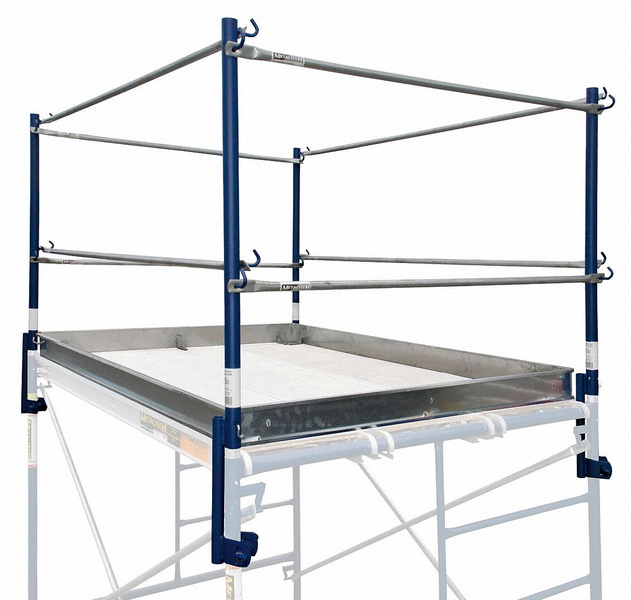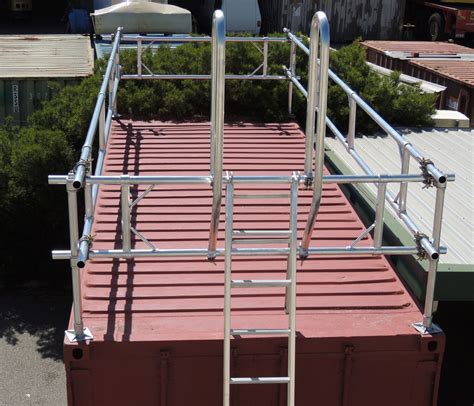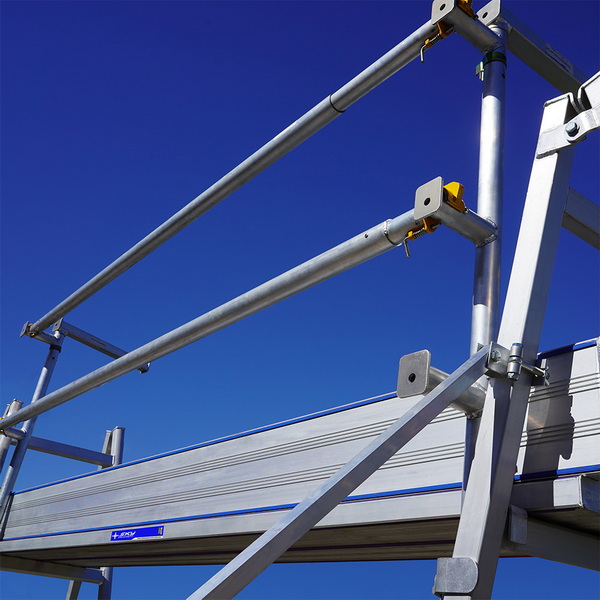Content Menu
● Introduction to A-Frame Handrail Scaffolding
● Features of A-Frame Handrail Scaffolding
● Step-by-Step Installation Guide
>> 1. Site Preparation
>> 2. Assembling the A-Frame Scaffolding
>> 3. Installing Handrails
● Safety Considerations
>> Handrail Requirements
>> Regular Inspections
● Case Studies: Successful Use of A-Frame Handrail Scaffolding
● Maintenance and Storage
● Future Trends in A-Frame Handrail Scaffolding
● Comparison with Other Types of Scaffolding
>> Trestle Scaffolding vs. Rolling Scaffolding
>> A-Frame Handrail Scaffolding vs. Bamboo Scaffolding
● DIY A-Frame Handrail Scaffolding
● A-Frame Handrail Scaffolding for Masonry and Veneer Work
● Conclusion
● FAQ
>> 1. What is the recommended height for handrails on scaffolding?
>> 2. How often should scaffolding be inspected for safety?
>> 3. What materials are used to make A-frame handrail scaffolding?
>> 4. Are there any safety certifications I should look for when purchasing A-frame handrail scaffolding?
>> 5. Can A-frame handrail scaffolding be customized for specific project needs?
● Citations:
Installing A-frame handrail scaffolding requires careful planning and execution to ensure safety and efficiency. In this article, we will guide you through the process of properly installing A-frame handrail scaffolding, highlighting key safety considerations and best practices.

Introduction to A-Frame Handrail Scaffolding
A-frame scaffolding is a versatile tool used in construction and renovation projects. It is known for its durability and ease of setup, making it ideal for both small-scale domestic projects and larger commercial ventures. The addition of handrails enhances safety by providing a barrier against falls and securing tools and materials.
Features of A-Frame Handrail Scaffolding
- Durability: Made from high-grade materials like Q-235 steel, A-frame scaffolding is sturdy and can withstand significant weight loads.
- Versatility: Available in various heights, it is suitable for both interior and exterior projects.
- Safety: Handrails provide a critical barrier to prevent accidents and ensure compliance with safety regulations.
Step-by-Step Installation Guide
1. Site Preparation
- Inspect the Site: Ensure the ground is level and stable. Remove any debris or obstacles that could interfere with scaffolding setup.
- Plan the Layout: Determine the size and configuration of the scaffolding based on project requirements.
2. Assembling the A-Frame Scaffolding
1. Attach Horizontal Braces: Secure horizontal braces to the vertical frames to stabilize the structure.
2. Add Diagonal Braces: Install diagonal braces to enhance stability and prevent the scaffolding from leaning.
3. Erect Frames: Stack frames according to the planned height, ensuring each frame is securely locked.
3. Installing Handrails
1. Mount Handrail Frames: Use fittings and lateral members to mount handrail frames between adjacent frames.
2. Secure Handrails: Ensure handrails are at least 950mm high and include intermediate rails spaced no more than 470mm apart.
3. Install Toe Boards: Add toe boards to prevent objects from falling off the platform.
Safety Considerations
Handrail Requirements
- Height: Handrails must be at least 950mm high to prevent falls.
- Intermediate Rails: Include intermediate rails spaced no more than 470mm apart to prevent objects from passing through.
- Toe Boards: Essential for preventing tools and materials from falling off the platform.
Regular Inspections
- Daily Checks: Inspect scaffolding daily for any damage or wear.
- Maintenance: Regularly maintain scaffolding components to prevent rust and damage.
Case Studies: Successful Use of A-Frame Handrail Scaffolding
A-frame handrail scaffolding has been successfully used in various projects worldwide. For example, in residential renovations, it provides a stable and safe platform for painting and roofing tasks. In commercial settings, it supports large-scale construction projects by offering a reliable and efficient working platform.

Maintenance and Storage
Proper maintenance and storage are crucial to extend the lifespan of A-frame handrail scaffolding:
- Cleaning: Regularly clean the scaffolding to prevent rust and corrosion.
- Storage: Store scaffolding in a dry area, away from direct sunlight and moisture.
- Inspection: Regularly inspect scaffolding components for any signs of wear or damage.
Future Trends in A-Frame Handrail Scaffolding
The future of A-frame handrail scaffolding is likely to involve advancements in materials and design, focusing on increased safety and efficiency. Innovations such as lightweight materials and modular designs will continue to enhance the versatility and usability of these scaffolding systems.
Comparison with Other Types of Scaffolding
Trestle Scaffolding vs. Rolling Scaffolding
- Trestle Scaffolding: Ideal for smaller projects, lightweight, and easy to assemble.
- Rolling Scaffolding: Offers greater mobility with caster wheels but requires more space and setup effort.
A-Frame Handrail Scaffolding vs. Bamboo Scaffolding
- A-Frame Handrail Scaffolding: Durable, easy to set up, and suitable for various weather conditions.
- Bamboo Scaffolding: Eco-friendly, cost-effective, but less durable and more labor-intensive to set up.
DIY A-Frame Handrail Scaffolding
For those interested in a more budget-friendly option, DIY A-frame handrail scaffolding can be made using timber and basic hardware. This approach allows for customization and can be a fun DIY project.
A-Frame Handrail Scaffolding for Masonry and Veneer Work
A-frame handrail scaffolding is particularly useful in masonry and veneer work due to its stability and ease of setup. It provides elevated access to work areas, making it ideal for projects involving brick and stone masonry.
Conclusion
Properly installing A-frame handrail scaffolding is crucial for ensuring safety and efficiency on construction sites. By following the step-by-step guide and adhering to safety regulations, you can create a stable and secure working environment.

FAQ
1. What is the recommended height for handrails on scaffolding?
Handrails should be at least 950mm high to comply with safety regulations and prevent falls.
2. How often should scaffolding be inspected for safety?
Scaffolding should be inspected daily for any damage or wear, with regular maintenance checks to prevent rust and damage.
3. What materials are used to make A-frame handrail scaffolding?
A-frame handrail scaffolding is typically made from high-grade steel or aluminum, ensuring durability and strength.
4. Are there any safety certifications I should look for when purchasing A-frame handrail scaffolding?
Yes, ensure that the scaffolding complies with local safety standards, such as AS/NZ 1576.3 in Australia.
5. Can A-frame handrail scaffolding be customized for specific project needs?
Some models offer adjustable heights and additional accessories to fit specific project requirements.
Citations:
[1] https://www.datocms-assets.com/48781/1626165723-mounting-instruction-scaffolds-st-rt-fteng.pdf
[2] https://www.turboscaffolding.com.au/blog/handrails-and-toe-boards-are-vital-for-scaffolding-safety/
[3] https://patents.google.com/patent/US6732836B2/en
[4] https://www.haspod.com/blog/construction/scaffold-handrail-height
[5] https://www.jumbo.as/wp-content/uploads/2020/12/JUMBO_facade4mm_UK.pdf
[6] https://www.ihsa.ca/rtf/health_safety_manual/pdfs/equipment/Scaffolds.pdf
[7] https://www.huennebeck.com/uploads/files/bosta_100_user_guide_en_2018-12_2.pdf
[8] https://www.tokubetu.or.jp/text_ashiba_en/text_ashiba1-2e_en.html






















